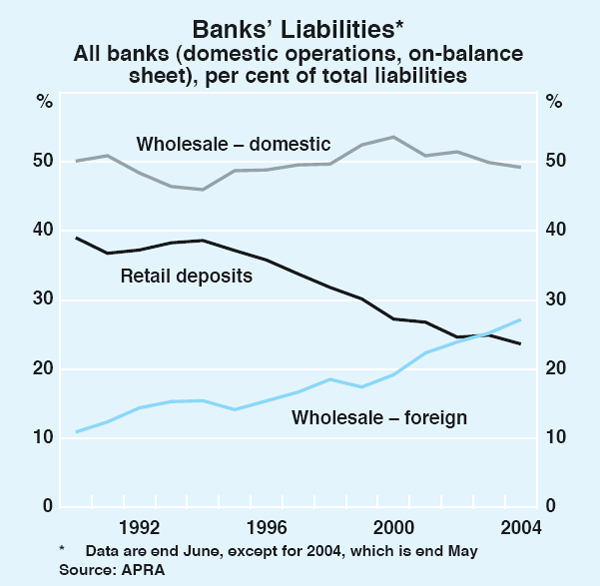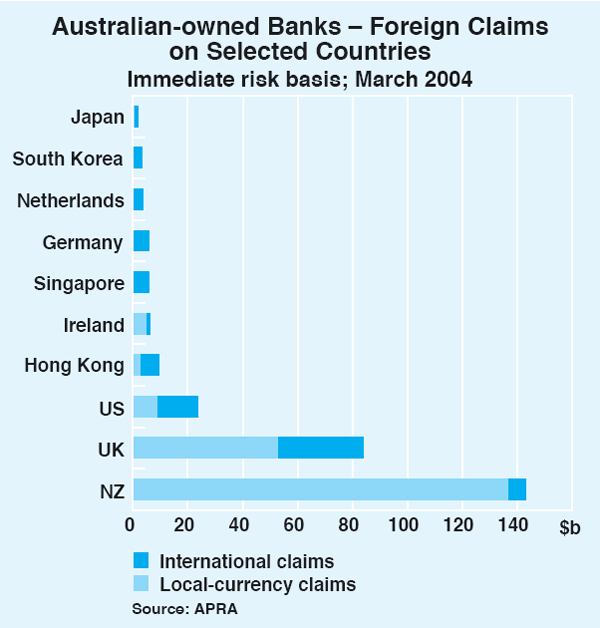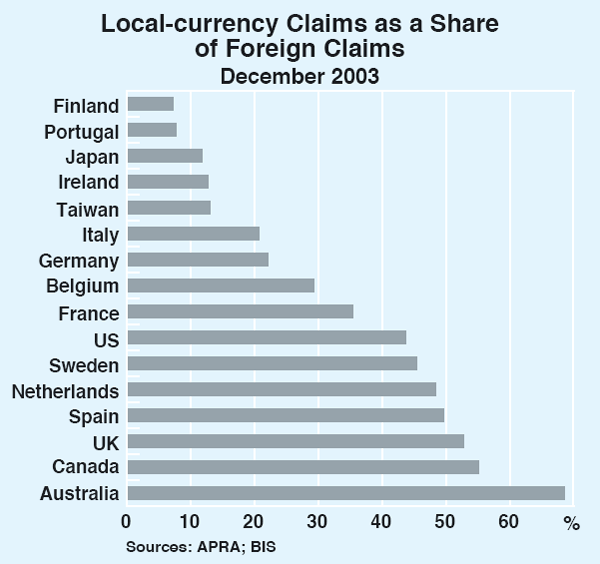Bulletin – July 2004 International Banking Statistics for Australia[1]
- Download 76KB
The Australian financial sector plays an important role in intermediating borrowing and lending between Australia and the rest of the world. A comprehensive picture of the resulting international assets and liabilities of Australian banks is now available through an upgraded data collection by the Australian Prudential Regulation Authority (APRA). In particular, this collection, which was designed in conjunction with the Reserve Bank and meets international best practice, as set by the Bank for International Settlements (BIS), significantly improves the information available on international asset exposures. This article explains the concepts underlying the new international banking statistics, and explores what the data reveal about Australian banks' international assets and liabilities.[2] Commencing with this issue of the Bulletin, international banking statistics will be published in three new tables (B.11 – B.13).
Types of International Banking Statistics
International banking statistics (IBS) are collected on two different bases. The first, termed locational data, measures cross-border capital flows intermediated through a country's financial sector. These data measure the gross claims and liabilities of all banks located in a reporting country vis-à-vis entities located in other countries.[3] The second, termed consolidated data, measures the foreign claims (but not the liabilities) of a country's financial sector. Unlike the locational data, the consolidated data capture the foreign claims of the head office and all its branches and subsidiaries on a worldwide consolidated basis, excluding positions between offices of the same group.
The differences between the locational and consolidated data can be illustrated by the example of a London branch of an Australian bank (say ABC Bank) that has lent $15 million to a French company (Graph 1). The London branch funds the loan by borrowing $10 million from its Australian head office and $5 million from a UK-based bank (XYZ Bank). For the locational data, the Australian resident bank (ABC Bank, Sydney) would report a $10 million claim on a UK resident bank (ABC Bank, London), reflecting the capital flow from Australia to the UK. For the consolidated data, ABC Bank, Sydney would report a $15 million claim on a French non-bank counterparty reflecting its total risk exposure to the ultimate counterparty.[4]

Locational Data
As at March 2004, international assets of Australian-located banks totalled $170 billion, compared to international liabilities of $383 billion. As a ratio to GDP, these gross exposures are not large by international standards, with a number of countries that operate as international financial centres having much higher ratios (Table 1). In contrast, the net liability position of Australian banks, as a ratio to GDP, is the second highest amongst the countries reporting data to the BIS. This reflects the Australian banks' increased reliance on foreign funding to finance a rate of domestic asset growth much faster than the growth in retail deposits (Graph 2).
| International assets | International liabilities | Net liabilities | |||
|---|---|---|---|---|---|
| 1. Singapore | 558 | 1. Singapore | 558 | 1. Portugal | 46 |
| 2. Hong Kong | 330 | 2. Hong Kong | 309 | 2. Australia | 29 |
| 3. Switzerland | 283 | 3. Switzerland | 277 | 3. Spain | 18 |
| 4. Ireland | 240 | 4. UK | 246 | 4. Denmark | 14 |
| 5. UK | 237 | 5. Ireland | 227 | 5. Norway | 12 |
| 20. Australia | 23 | 15. Australia | 51 | ||
|
(a) Based on the 38 countries reporting locational data to the BIS but excluding Luxembourg and 9 offshore centres. Together, the excluded countries account for around 15 per cent of total assets and liabilities reported. Sources: APRA; BIS; IMF |
|||||

Around half of the banks' international liabilities are in the form of debt securities (Table 2). The remaining liabilities are split fairly evenly between deposits and ‘other liabilities’, which includes outstanding derivative contracts with a negative market value, and working capital received by local branches of foreign banks from their head offices offshore. In contrast, the assets are dominated by loans and ‘other assets’, which includes outstanding derivative contracts with a positive market value, and working capital supplied by head offices of Australian banks to their branches abroad.
| Assets | Liabilities | |||
|---|---|---|---|---|
| $b | Per cent of total | $b | Per cent of total | |
| Total | 170 | 100 | 383 | 100 |
| By product type | ||||
| Loans/Deposits | 69 | 41 | 114 | 30 |
| Debt securities | 9 | 5 | 183 | 48 |
| Other | 92 | 54 | 86 | 22 |
| By counterparty | ||||
| Related bank | 44 | 26 | 70 | 18 |
| Other bank | 66 | 39 | 171 | 45 |
| Non-bank | 61 | 36 | 142 | 37 |
|
Source: APRA |
||||
By counterparty type, the structure of international assets and liabilities is more alike. The bulk of positions are claims on, or liabilities to, banks, with bank counterparties accounting for almost two-thirds of both assets and liabilities. Within these, positions with related banks are prominent.
By country, the bulk of foreign liabilities is owed to entities located in the UK and the US, which together account for 67 per cent of international liabilities (Table 3). There are relatively few major countries against which banks located in Australia have a net asset position. The largest net asset position is against New Zealand, reflecting, in part, the funding that the New Zealand operations of the Australian banks receive from their head offices.
| Assets | Liabilities | Net position(a) | |||
|---|---|---|---|---|---|
| Country | $b | Per cent of total | $b | Per cent of total | $b |
| UK | 35 | 21 | 172 | 45 | −137 |
| US | 26 | 15 | 83 | 22 | −57 |
| NZ | 14 | 8 | 5 | 1 | 9 |
| Singapore | 9 | 5 | 14 | 4 | −4 |
| Japan | 8 | 5 | 12 | 3 | −4 |
| Hong Kong | 6 | 4 | 26 | 7 | −20 |
| France | 4 | 3 | 3 | 1 | 2 |
| Other countries | 26 | 16 | 41 | 11 | −14 |
| Total: non-residents | 129 | 76 | 356 | 93 | −227 |
| Australia | 41 | 24 | 28 | 7 | 14 |
| Total | 170 | 100 | 383 | 100 | −213 |
|
(a) Assets less liabilities Source: APRA |
|||||
The US dollar is the most important currency of denomination, accounting for around 40 per cent of both assets and liabilities (Table 4). Reflecting that international liabilities exceed assets, Australian-located banks have a net foreign currency liability position, which in March 2004 stood at $166 billion. However, as discussed in previous work by the Reserve Bank, the vast bulk of the currency risk associated with this position is hedged through the derivatives market.[5] In recent years, the effectiveness of the banks' hedging has been evidenced by only limited variation in the sector's earnings in the face of sharp movements in the Australian dollar.
| Assets | Liabilities | Net position(a) | |||
|---|---|---|---|---|---|
| Currency | $b | Per cent of total |
$b | Per cent of total |
$b |
| AUD | 44 | 26 | 91 | 24 | −47 |
| USD | 66 | 39 | 160 | 42 | −94 |
| EUR | 14 | 8 | 39 | 10 | −26 |
| JPY | 5 | 3 | 15 | 4 | −10 |
| GBP | 11 | 6 | 34 | 9 | −23 |
| NZD | 13 | 8 | 9 | 2 | 4 |
| Other currencies | 18 | 11 | 35 | 9 | −17 |
| Total | 170 | 100 | 383 | 100 | −213 |
| of which: non-AUD | 127 | 74 | 292 | 76 | −166 |
|
(a) Assets less liabilities Source: APRA |
|||||
Consolidated Data
As noted above, the consolidated data measure the foreign claims of the financial sector on a global consolidated basis (although the market value of derivative positions are excluded). In March 2004, consolidated foreign claims of all banks in Australia totalled $357 billion. The foreign claims of Australian-owned banks, as opposed to all banks operating in Australia, were $309 billion, which amounts to around a quarter of their total assets.
The value of consolidated foreign claims is well above the value of foreign assets reported in the locational data, predominantly reflecting the extensive operations of the Australian banks abroad. These operations create an overseas exposure but, to the extent that they are funded in overseas markets, do not create a capital flow. As with the locational data, Australian-owned banks' total claims are relatively small compared to those of countries that act as international financial centres or that have domestic banks with very large international operations (Table 5).
| 1. Switzerland | 506 |
|---|---|
| 2. Netherlands | 232 |
| 3. Ireland | 229 |
| 4. Belgium | 216 |
| 5. Germany | 107 |
| 12. Australia | 41 |
|
(a) Based on the 30 countries reporting consolidated data for domestically-owned banks to the BIS on an immediate risk basis. Sources: APRA; BIS; IMF |
|
For the Australian banking system as a whole, the ratio of foreign claims to total assets has remained broadly steady since 1990, though there have been some large shifts in geographic composition.[6] Exposures to New Zealand have increased from 14 per cent of foreign claims in March 1990 to around 45 per cent in March 2004, largely as a result of bank acquisitions in New Zealand (Table 6). The next largest exposures are to the UK, which account for around a quarter of foreign claims. As a share of foreign claims, exposures to Japan and the US have fallen significantly since the early 1990s, with exposures to Japan now accounting for less than 1 per cent of the total.
| Country | March 1990 | March 1996 | March 2004 |
|---|---|---|---|
| NZ | 14.0 | 29.0 | 44.8 |
| UK | 27.2 | 24.7 | 24.3 |
| US | 16.6 | 11.4 | 8.2 |
| Hong Kong | 1.9 | 2.1 | 2.3 |
| Singapore | 0.9 | 1.8 | 1.5 |
| Japan | 17.3 | 9.8 | 0.6 |
| Other countries | 22.1 | 21.2 | 18.3 |
| Total | 100.0 | 100.0 | 100.0 |
|
(a) Data are for all banks located in Australia in 1990 and 1996, and for Australian-owned banks in 2004. Source: APRA |
|||
The Australian banks' foreign claims arise from two main types of activity. The first is where funds are raised in one country and lent in another (termed ‘international claims’);[7] and the second is where banks hold assets in a foreign market funded by liabilities raised in that market (giving rise to ‘local-currency claims’).[8] The bulk of Australian banks' exposures to New Zealand, the UK and Ireland are of the latter type, representing local-currency claims on residents of those countries by the local branches and/or subsidiaries of Australian-owned banks (Graph 3). In March 2004, Australian-owned banks' local-currency claims were $211 billion, while their international claims were $97 billion.

Reflecting these exposures, the share of local-currency claims in total foreign claims for Australian-owned banks is high by international standards (Graph 4). Notwithstanding this, the share of local currency claims in banks' total exposures has been increasing worldwide, partly reflecting banks in advanced economies establishing or acquiring banking operations in developing economies.

One way that banks manage country risk is through the use of risk-transfer mechanisms. For example, a bank in Australia may lend to a company in Italy on the basis that it is provided with a guarantee issued by a US-owned bank. Thus, the immediate (or contractual) counterparty is in Italy, but the ultimate counterparty, should the Italian company be unable to repay the loan, is in the US. In March 2004, the effect of Australian-owned banks' use of risk-transfer mechanisms on their overall foreign exposure was negligible (Table 7). By country, however, there was a modest reduction in their exposure to the UK and New Zealand, whereas exposures to Germany and the Netherlands increased, possibly reflecting the international activities of the large banks and insurers based in those countries.
| Country | Immediate risk | Ultimate risk |
|---|---|---|
| NZ | 143 | 138 |
| UK | 84 | 75 |
| US | 24 | 25 |
| Germany | 6 | 11 |
| Netherlands | 3 | 7 |
| Hong Kong | 9 | 7 |
| Ireland | 6 | 6 |
| Singapore | 6 | 5 |
| France | 3 | 4 |
| South Korea | 3 | 3 |
| Canada | 1 | 3 |
| Other countries | 21 | 23 |
| Total | 309 | 308 |
|
Source: APRA |
||
In terms of counterparties, nearly two-thirds of the foreign claims of Australian-owned banks are on the non-bank private sector, while claims on banks account for a further 27 per cent (Table 8).
| Counterparty/Type | $b | Per cent of total |
|---|---|---|
| Banks | 83 | 27 |
| Public sector | 17 | 6 |
| Private sector | 199 | 65 |
| Unallocated | 9 | 3 |
| Total | 308 | 100 |
| of which: Cross-border | 86 | 28 |
| Local | 222 | 72 |
|
Source: APRA |
||
Data on asset maturity are available for only the international claims subset of total foreign claims – that is, excluding local-currency claims on local residents – which for Australian banks is the smaller component. These data show that short-term claims (less than 3 months) account for 40 per cent of international claims, with exposures maturing within 12 months accounting for 55 per cent of exposures. This maturity structure appears to be broadly in line with that of comparable countries (Table 9).
| Maturity | Australia | Canada | UK | US |
|---|---|---|---|---|
| <1 yr | 55 | 66 | 49 | 65 |
| 1–2 yrs | 7 | 7 | 2 | 0 |
| >2 yrs(b) | 32 | 26 | 11 | 35 |
| Unallocated(c) | 7 | 0 | 38 | 0 |
|
(a) Cross-border claims and local claims in foreign currency of domestically-owned
banks. For the US, local claims in foreign currencies are excluded. Sources: APRA; BIS |
||||
Conclusion
The new international banking statistics provide additional detail on the structure of the Australian financial sector's international assets and liabilities. These data confirm that Australian financial institutions have a large net foreign liability position, with foreign funding accounting for around a quarter of the liabilities of the banks' domestic operations. These foreign liabilities are predominantly raised in the UK and the US and mainly take the form of debt securities. The data also show that Australian banks have considerable assets overseas, mainly in developed countries, though they are less geographically diversified than was the case a decade ago, reflecting the strong growth in assets in New Zealand. As noted in previous work by the Reserve Bank, these international activities of Australian financial institutions give rise to relatively little currency risk due to the extensive use of derivatives to hedge foreign currency exposures.
Footnotes
This article was prepared by Mustafa Yuksel and Carl Schwartz of System Stability Department. [1]
For simplicity, references to international banking statistics for banks also include statistics for the larger Registered Financial Corporations completing the revised reporting requirements. [2]
The locational data also include transactions with local residents denominated in foreign currency. [3]
The UK resident bank (ABC Bank, London) would report to the UK authorities a $15 million locational claim on a French non-bank counterparty and a $10 million locational liability to its Australian head office. In the consolidated data, UK-owned XYZ Bank would report a $5 million claim on an Australian bank counterparty. [4]
See ‘Foreign Exchange Exposures of Australian Banks’, RBA Bulletin, August 2000; ‘Australia's Foreign Currency Exposure and Hedging Practices’, RBA Bulletin, August 2002; and ‘Financial System Stability’, RBA Annual Report 2003. [5]
These conclusions are drawn from the return that preceded the revised reporting arrangements, which was not as detailed in its scope or coverage, limiting the comparability of prior years' data with the current data. [6]
‘International claims’ comprise cross-border claims and banks' foreign offices' claims on local residents in foreign currencies (on the assumption that the bulk of foreign currency claims is funded elsewhere). [7]
‘Local-currency claims’ measure banks' foreign offices' claims on local residents in local currencies. [8]